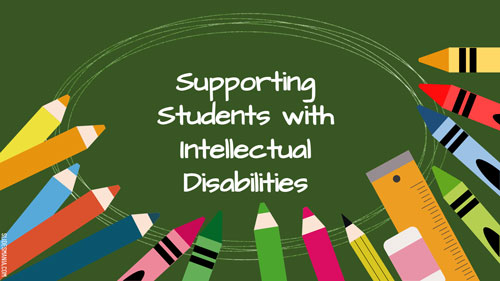SPED Quick Links
How Can I Support a Child with an Intellectual Disability?
On this page we will provide some strategies for how to help teach and support a student with an intellectual disability. These strategies can be very effective in helping students to process and understand new information and concepts.
Children with intellectual disabilities can face many challenges with learning. These might include:
- Difficulty with learning new information, especially abstract concepts
- Difficulty processing information sequentially
- Difficulty in developing social and communication skills
- Increased time for cognitive processing to learn new skills
Instructional Strategies Suggestions
The following instructional strategies are helpful in making the information accessible to students with intellectual disabilities. These approaches allow the student to understand abstract concepts in a more concrete way.
- Use visuals. This includes pictures, charts, diagrams, tables, etc. Visuals reduce the number of words and can show an idea in a more concrete way.
- Break instruction into smaller steps. This allows the student to take more time to process the information and prevents information overload which could confuse the student. This also helps ensure mastery as the student must master one concept before moving on to the next.
- Minimize lengthy verbal instructions. As mentioned above, students with intellectual disabilities thrive and progress more with visual aids or demonstrations. This is because they have difficulty with abstract ideas. If all the information is presented verbally, the student may not be able to understand or process what is being said.
- Incorporate more physical learning experiences that involve kinesthetic movement. Many concepts can be brought to life by asking students to use part of their body or movement to represent an idea. For example, if you are teaching students how to calculate the area of a rectangle, ask the student to stand up and walk the length of one side of the rectangle and walk the length of the other side of the rectangle as you explain the formula for how to calculate area.
- Provide immediate feedback. Many students, including students with intellectual disabilities, benefit from input that is given at the time of instruction. This is because the information is fresh in their mind, and they are able to process the feedback in their short-term memory more quickly and more efficiently. This technique can also be used to provide positive reinforcement and celebrate success should a student perform a task successfully.
- Use music, songs, or jingles. When information is provided in multiple forms, there is a higher likelihood of retention.
In summary, to help students with intellectual disabilities learn, consider using a multi-modality approach to learning and present the information in visual, auditory, and kinesthetic ways. This will help break down abstract concepts into ideas that are more accessible and understandable to the student.
If you would like more information about students with intellectual disabilities, you can visit this website:
American Association of Intellectual and Developmental Disabilities
https://www.aaidd.org/

